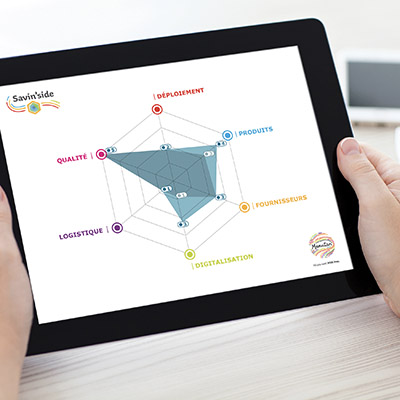In today's business landscape, every company must maintain a high level of efficiency and productivity to remain competitive. In this dynamic and complex environment, business process mapping is a powerful tool for better understanding process flows and their interactions. Through this approach, businesses can simplify, streamline, and optimise their current process, with the ultimate goal of creating value for the end users. It's an essential milestone for ensuring process control and continuous improvement.
Process mapping: Definition and benefits
Business process mapping consists of graphically representing the activity of all or part of a company. This visual management technique is used to describe and analyse the different stages of a process. It provides a detailed view of the flow of activities and information, from input to output, offering a comprehensive view of how an organisation works.
In their works on the subject, Florence Gillet-Goinard and Bernard Seno explain: "Process mapping no longer represents the company in the form of a flowchart (starting at the top and working downwards), but as a set of cross-functional processes aimed at customer satisfaction. [...] It gives key stakeholders an objective reading of the company's activity, beyond the artificial boundaries of flowcharts."
Business process mapping can identify areas of waste, inefficiencies, redundancies, or bottlenecks in a process. This serves as a working basis to optimise operations, team collaboration, and employee engagement.
It's important to note that process mapping is part of a process approach initiated by the company's management. It's one of the first steps in implementing business process management, as well as a quality management system certification project (ISO 9001 standard).
What are the three types of processes?
Process mapping distinguishes three main categories of process: Business processes, support processes and management processes.
Realisation processes
Realisation processes, also called business or operational processes, are the company's raison d'être. They are integrated into the value chain and contribute to customer satisfaction. This includes design, production, marketing, and delivery of products and/or services.
Support processes
Support processes provide the necessary resources for realisation processes to work. These include processes related to human resources, finance, accounting, or procurement, for example.
Management processes
Management processes, also known as steering or direction processes, serve to organise work. They enable strategic decision-making and activity monitoring.
These three process types compose what is called a "macro-process" and collectively contribute to achieving a major goal for the company. For example, in manufacturing, a macro-process might cover product design through to delivery, including all associated stages.
The 7 key steps of process mapping
To successfully map your company's processes, follow a structured sequence of steps.
1. Defining the objective
The first step is to define clear process mapping objectives. These objectives must be aligned with the company's mission, vision, and strategy. The various stakeholders need to be involved in this key step. Objectives can include improving operational efficiency, reducing production costs, or optimising procurement. Let's use the latter as an example to detail each of the following steps.
2. Defining the process to map
The second step involves choosing the process to map. This could be a realisation, support, or management process. This exercise must take into account the company's priorities and key performance indicators (KPIs).
For procurement optimisation, you might map the Source-to-Pay or Procure-to-Pay process, for example. For guidance, it's important to rely on key performance indicators governing the procurement departments, such as return on investment or overall procurement contribution.
3. Collecting information
The third step is dedicated to collecting detailed information about each process. To gather this data, you can rely on employee interviews, workshops, analysis of existing documents, or field observations. This is how you collect necessary input data and expected output data.
In procurement optimisation, this is an opportunity to examine documentation (procurement policy, validation protocols, supplier policies) and data from digital tools (purchasing volume, return rates, supplier service rates). It's essential to complement these insights through exchanges with procurement teams and related stakeholders.
4. Identifying stakeholders
The fourth step's purpose is to identify the people or teams involved in the process. This is typically done simultaneously with data collection. It's crucial to mobilise various stakeholders around this project. In our scenario, this involves procurement teams, accounts payable, decision-makers, internal customers, and suppliers.
5. Choosing the modelling language
The fifth step focuses on choosing the mapping format:
- Flow diagrams;
- SIPOC (Suppliers, Inputs, Process, Outputs, Customers);
- Swimlane (or cross-functional process map);
- Value Stream Map, etc.
This will depend on initially set objectives and the desired detail level. This decision determines how processes will be represented, subsequently influencing their analysis.
For procurement optimisation, Value Stream Mapping is recommended. This Lean Management technique usually provides a better understanding of flows, identifies waste and optimises operations.
6. Drawing the process diagram
The sixth step involves creating the process diagram. Document each process step, including all information (procedures, policies, instructions, etc.) that helps understand the process.
Once this has been done, the resulting diagram reflects operational reality, allowing easy identification of process improvement opportunities.
7. Validating with stakeholders
The final step focuses on sharing the mapping with previously identified stakeholders, i.e., the procurement team but also related players. This is an opportunity to gather their feedback to refine the mapping. This ensures the procurement process is correctly represented and understood by all.
Following this work, the project team has all the tools to achieve its objective: Optimising procurement. They can analyse the mapping, identify challenges, and progression opportunities. They might consider implementing e-procurement solutions, strengthening supplier contract deployment, or establishing standardised operational procedures.
As you can see, business process mapping makes problems visible, so that the most appropriate solutions can then be envisaged. It's more than a basic graphic—it's a strategic lever for improving overall company performance.









